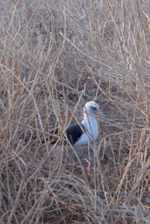Threats to Birds
- Golden Crownbeard (Verbesina encelioides)
Overview
During the breeding season, over 1 million birds are densely packed onto Midway Atoll National Wildlife Refuge. The 1,600-acre refuge is at the heart of the newly created Northwestern Hawaiian Islands Marine National Monument, and is home to the world's largest breeding populations of the Laysan Albatross, Black Noddy, White Tern, and Red-tailed Tropicbird. The endangered Short-tailed Albatross and the endangered Laysan Duck are also found there. Among the 225 non-native plants on Midway, golden crownbeard is the most invasive. Golden crownbeard seeds were probably brought to Midway in more than 9,000 tons of soil that was imported to grow shade trees, ornamental plants, and food for people who once lived on the military base. Golden crownbeard may also have also been introduced as an ornamental plant or via seeds on equipment. On Sand Island, the largest of Midway's three islands, the area invaded by golden crownbeard increased from 44 acres in 1991 to 148 acres in 2004 -a 230% increase. Eastern Island also recorded a significant increase, from 74 acres in 1991 to 131 acres in 2004.
Description
Golden crownbeard, scientific name, Verbesina encelioides, is in the Asteraceae familly of annual flowering shrubs. It is native from North America to the tropics, where it grows in stands from 1 to 5 feet tall from sea level to 9,000 feet elevation. As an invasive weed on Midway, it grows aggressively in stands up to 8 feet tall in soils, sand, and between cracks in asphalt. It shades out native vegetation and competes for nutrients and water (though it is drought tolerant, requiring only monthly watering once established). It also produces chemicals toxic to native plants. Flowers produce up to 350 seeds by both cross- and self-pollination. Stands self-seed annually and are dispersed by wind The seeds exhibit highest rate of germination in open, disturbed areas with sandy soils.
Golden crownbeard affects birds in the following ways:
Birds Affected
Golden crownbeard is reducing nesting habitat for all ground-nesting birds on Midway, but is of particular concern for nesting Laysan Albatrosses.
Control
The U.S. Fish and Wildlife Service's golden crownbeard management program on Midway began in the late 1990s, and intensified in 2003. This very labour and time intensive program has included control by hand-pulling, mowing, and herbicide application. Native plants are propagated in areas where crownbeard has been eradicated to help restore a natural ecosystem, and prevent recolonization by crownbeard or other invasive plants. In order to reverse the problems caused by golden crownbeard and prevent re-occurance all of the following must be done:
|
